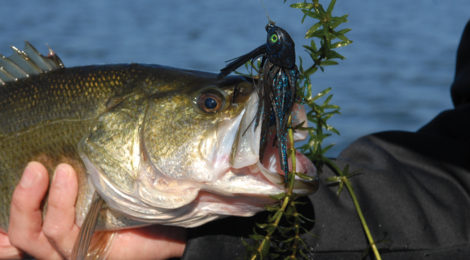
The Jig is Up
Simulating a slow moving offering these baits will likely catch the biggest fish.
Story and Photography by Matt Williams
Bass junkies share differences of opinion on plenty, but if there is one thing we all agree on it’s that jigs will catch some of the biggest fish in the lake. That’s largely because jigs are designed to easily penetrate the thick cover where heavyweight largemouths like to set up camp. Plus, they simulate a slow-moving offering that represents a tasty and sizable meal.
There’s nothing complicated about the anatomy of the bait. It consists of a lead head molded around a hook that is usually protected by some sort of weed guard to help the bait get in and out of logs, limbs and grass without fouling or hanging up. The hook is hidden beneath a living rubber or silicone skirt that undulates with the bait’s every move. Most anglers like to outfit the jig with some sort of plastic trailer to enhance the action, create an even larger profile and cause the bait to move more water. A trailer also can make a bait more buoyant and slow the fall rate to a degree.
Like other families of lures, jigs have undergone some big time changes over the years. Back in the 1970s, when rubber-skirted jigs started gaining popularity within the bass fishing community, there were limited designs available for performing a broad range of techniques. To hear Lonnie Stanley tell it, if you wanted to swim a jig through shallow shore grass or lotus pads, you did it with the same jig you used to fish around thick vegetation, brush, rocks and other junk.
“Back in the early days we didn’t have all the different jigs and head designs that we have now,” said Stanley, a well-known lure designer from Huntington who introduced the first Stanley Jig in 1979. “Things are a lot more specialized now. There are jigs for all sorts of different techniques.”









